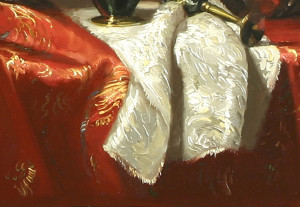This past week, I had the pleasure of participating in the Oil Painters of America Critique Program. For the nominal fee of $25.00 (which goes to OPA), artists have the opportunity to have a signature or master level member review their oil paintings and give instructional advice on how they might improve their technique. Because I do not do any formal teaching at this time, I feel this is my way of giving back to the art community, and I thoroughly enjoy this task.
Looking back through the critiques I have done for OPA, there are certain techniques that I see repeated by beginners. If I could give just one important bit of advice, it would be to use more paint. One of the most beautiful benefits of oil paint’s properties is the viscosity of the paint itself. Juicy impasto adds tremendous interest and excitement to an oil painting.

Look at your current canvas sideways across the surface and take note of how thick the oil paint actually is. My guess it’s pretty thin. Begin to think sculpturally. Squeeze lots of paint onto your palette. Once you do this, you will feel compelled to use it up. Don’t be miserly, even with the more spendy pigments. In the above painting, Secret Life of Iris, I have used natural cinnabar, which can be expensive, but I did not let that hold me back.

Use the thick strokes of paint in your area of focus. Place pieces of paint and leave them alone. Don’t fuss and blend. Be bold. Make a statement with paint. This painting is from my Minerals, Metals, and Dirt project and is painted on copper. Because the copper is completely non-absorbent, the paint builds easily on the surface.

Contrarily, use thin translucent paint in the areas of shadow and background. This push and pull will give the viewer lots to do while their eyes travel around the composition. Give them something to think about so they don’t exit the painting too quickly. The tulips in Cupid’s Arrow illustrate both thickness and varieties (directions) of brushstrokes. What experience have you had with impasto applications? Have you noticed a difference in the beauty of the surface after applying thicker paint with varieties of strokes? Let us know your thoughts.
On a final note, some readers called me to mention that the link to the Salon International 2014 Award was not working correctly. Here is the working one.

You’re so right, yet I have never had an instructor talk about the amount of paint to use.
I once tried to copy a Van Gogh and couldn’t bring myself to use the thick paint that he
did. Even tho he was quite poor, he used his paints freely, but I have such a difficult
time with that. Good insight into my thinking. I hope to do better next canvas.
Thank you for your input and all the great paintings.
Penny
Penny, The fact that you have never had an instructor mention this is not surprising to me. I think I began to observe this phenomenon years ago when I was teaching. So many of my students put out tiny bits of paint as if they were precious gems. Then they were fearful of using it up. Consequently, the surface of the canvas had nothing to captivate the viewer. Putting out generous amounts of paint will have the opposite effect and will make you want to use it all up. This will automatically add interest and excitement to your paintings. As I am painting, I talk to myself. One comment I repeatedly say is, ‘go for it’, there is nothing to lose. Let me know what your experience is the next time you try this. Margret
Your work is wonderful.
Thank you Jim!